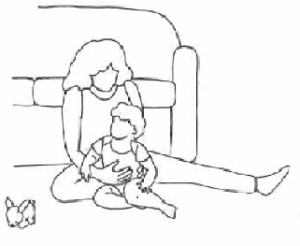Activities to develop crawling
Ideas and advice for parents and carers
General information
- Kneeling and crawling require more strength and coordination in your child’s arms and legs. This may take children with developmental delay longer to achieve.
- Some children “bottom shuffle” instead of crawling. You should still continue to encourage your child to practice moving in and out of four-point kneeling and crawling when they are ready, and quite often they will crawl at a later stage.
- Some children will “bear” crawl, for example, crawling on hands and feet rather than hands and knees.
Sequence
- “Reach and roll” lying on tummy
- Pulling forwards with both elbows on floor (creeping)
- Pulling forwards with one elbow at a time (commando crawling)
- Supported four-point kneeling
- Moving in and out of four-point kneeling
- Crawling
Activities
Reach and roll
Reach and roll
- Children reach forwards with one arm, then roll over that arm, followed by reaching with the other arm then rolling over that side.
- Place toys just out of reach to encourage them to stretch forwards.
- Many children progress from this to pulling themselves forwards on their elbows (creeping).

Creeping
- Children often start moving by pulling forwards on their elbows, using both elbows together.
- Your child may develop from this method to using one elbow at a time (commando crawling).
Commando crawling
Commando crawling

This means leaning to one side, propped on their elbow while reaching forwards with the opposite hand and pulling along. Then repeating the cycle on the other side. This teaches your child about controlling part of their body while moving another part.
Position
- On tummy, your hand over child’s bottom, when they reach forwards with one hand, gently stop them from rolling on to their side and encourage them to lean to the other side and reach with that hand instead
Encourage
- Child not to roll
- Pushing through feet, help them to learn this by placing your hands on the soles of their feet and push gently with alternate hands, encouraging your child to push back against you
- When reaching with the right hand, encourage pushing with right leg and vice versa
Play ideas
- Place a favourite toy or treat just out of reach to encouraging them to reach with one hand towards it
Supported four-point kneeling
Supported four-point kneeling
This means leaning to one side, propped on their elbow while reaching forwards with the opposite hand and pulling along. Then repeating the cycle on the other side. This teaches your child about controlling part of their body while moving another part.


More support position
- Place child in a crawling position, hands on the floor
- Rolled up towel or your leg under their tummy
- Hold child’s knees together and bent underneath them
Less support position
- Place child in a crawling position, hands on the floor
- Hold them around hips, and apply a gentle but firm downward pressure to maintain this position
- Aim for no support under their tummy
Encourage
- Legs together and not too wide apart
- Not pushing back with legs
- Supporting themselves on their arms
- Later, encourage child to rock back and forth or side to side to develop balance
Play ideas
- Water mat, small easy press toys
- Mirror
- Book
Moving into four-point kneeling
Moving into four-point kneeling

From sitting
- Turn their legs gently so both knees are pointing the same way (side-sitting)
- With your hands around their middle, gently guide child over to the side, encouraging them to put both hands down on the floor
- Gently help them lift their bottom up and across so they go into a crawling position
Initially, many children fall forwards on to their tummy so you may need to put your hand under their tummy at first, then take it away when your child is more confident.

From tummy
- Child starts on their tummy
- Encourage child to push up on their hands with arms straight
- Hold child around hips, gently guide their bottom up and forwards slightly so their knees come up under their hips
- Give light support under tummy if their arms tend to collapse
Moving out of four-point kneeling
To start with, most children fall forwards on to their tummies to get out of a four-point kneeling position. This progresses to a controlled lower to the floor, and then they will begin to be able to go from a four-point kneeling position into sitting. Eventually, they will begin to crawl once they are confident rocking in different directions on their hands and knees.
Moving from four point kneeling to sitting
- Gently guide child’s hips to one side and then across onto their bottom (side-sitting)
- Wait for them to “walk” their hands backwards so that they are balanced in sitting
- Practice to both sides
Crawling
Crawling
- To crawl, your child will need to be able to shift their weight to one side and balance while moving an arm or a leg.
- Your child will experiment by moving slowly, one limb at a time, and may fall on to their tummy frequently at first.
- Some children crawl on one foot and one knee, but usually progress to crawling on both knees.
- Trying to make your child crawl in a way they do not want to will frustrate both of you, so just continue encouraging them to move around as they choose.
Position
- Crawling position with hands under shoulders and knees under hips
- Knees not too wide apart
- Toys in front of one hand at a time
Encourage
- Knees to be closer together (they are often wide apart initially)
- Reaching forwards with one hand then the other
- The adult assisting can help child to move one leg forwards at a time as the child controls their arms
- Remember to move the leg on the same side as the arm that has moved!
Play ideas
- ‘Going on a bear hunt’
- Ball or crawling toy
- Any favourite toy or snack!


